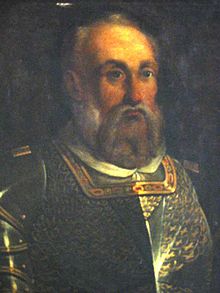Claude de la Sengle
| Claude de la Sengle | |
|---|---|
 |
|
| Grand Master of the Order of Saint John | |
|
In office 11 September 1553 – 18 August 1557 |
|
| Monarch |
King Charles II King Philip I |
| Preceded by | Juan de Homedes y Coscon |
| Succeeded by | Jean Parisot de Valette |
| Personal details | |
| Born | 1494 France |
| Died | 18 August 1557 (aged 62–63) Mdina, Malta |
| Resting place | St. John's Co-Cathedral (originally buried at Fort St. Angelo) |
| Nationality | French |
| Military service | |
| Allegiance |
|
| Battles/wars | Capture of Mehdia |
Fra' Claude de la Sengle (1494 – 18 August 1557) was the 48th Grand Master of the Order of Malta, from 1553 his death. His successor was Fra' Jean Parisot de Valette.
A native Frenchman, de la Sengle, then Bailli of the French langue of the Order, was heavily involved in the battles of the Knights against the Turkish corsair and Ottoman admiral Turgut Reis in the Mediterranean and in North Africa, and particularly in the struggles for Djerba and Tripoli.
De la Sengle had considerable impact on the military strengthening of Malta, notably by initiating in 1554 the development of the city of Senglea, which was later named after him and bears his coat of arms. He also expanded Fort Saint Michael into a major bastion and completed Fort Saint Elmo, which had been begun by his predecessor, Grand Master Juan de Homedes y Coscon.
Later on, Charles V wanted to grant Mehdia to the Order, but the commission that was set up decided that it would be too expensive to maintain. Therefore, Charles V ordered the Viceroy of Sicily, Juan de Vega, to destroy it to prevent Muslim occupation. De Vega did burn Mehdia, but retaliated against Malta for not accepting the city, and prohibited exportation of wheat to the island. To combat this, Sengle brought the engineer Vincenzo Vogo to Malta to upgrade the mills so the population would not starve.
The Valletta tornado most likely occurred during Sengle's reign in 1555 or 1556, although some sources say that it occurred in 1551. According to some sources, four galleys named Santa Fè, San Michele, San Filippo and San Claudio, capsized in the tornado and help arrived from abroad for the Order to acquire new galleys to replace them. In 1557, Prior François De Lorena commanded five of the Order's galleys and they engaged a Muslim fleet off Rhodes. They were defeated and many lives were lost. The remaining galleys arrived at the Grand Harbour on 17 June, and de la Sengle and many others cried when hearing about the loss of loved ones.
...
Wikipedia
